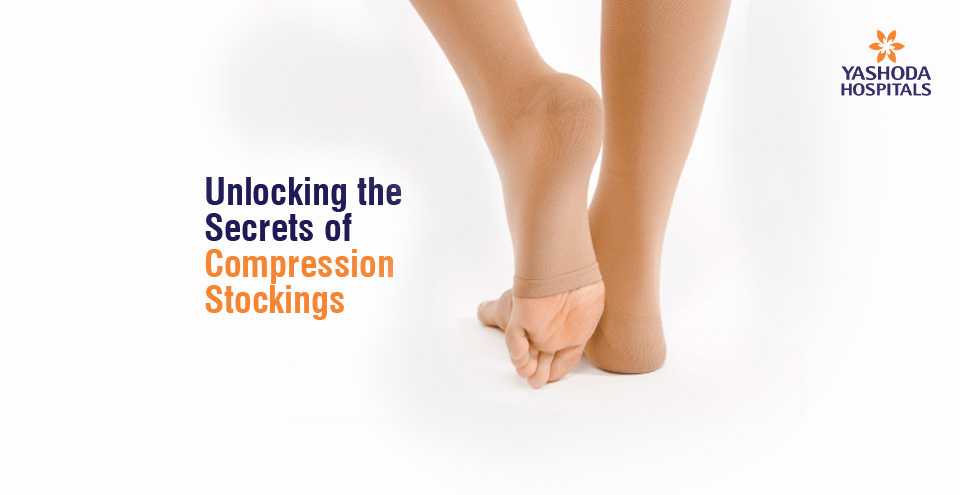Unlocking the Secrets of Compression Stockings

Compression stockings, once primarily associated with medical conditions, have now become a mainstream accessory for many. From athletes to frequent flyers, people are embracing the benefits of compression stockings beyond their traditional medical uses. But what exactly are compression stockings, and how do they work? Let’s unlock the secrets behind these seemingly simple garments, exploring their benefits, potential risks, and how to choose the right pair wisely.
Understanding Varicose Veins:
.Before we delve into the mechanics and applications of compression stockings, it’s essential to understand the condition they often address: VARICOSE VEINS. These enlarged, twisted veins typically occur when the valves within the veins weaken or fail, causing blood to pool and veins to swell. Varicose veins often manifest in the legs and may lead to symptoms such as pain, heaviness, swelling, and skin changes.

How Compression Stockings Help:
Compression stockings for varicose veins are elastic garments worn around the legs, designed to improve blood circulation. They exert gentle pressure on the legs, helping to squeeze blood vessels and promote better blood flow back to the heart. thereby reducing the likelihood of various vascular complications. This simple yet effective mechanism forms the foundation of their diverse applications in both medical and non-medical contexts.

Uses of Compression Stocking:
- Venous Disorders: Compression stockings are frequently prescribed for individuals with venous insufficiency, varicose veins, or deep vein thrombosis (DVT). They help improve blood flow in the legs, reduce swelling, and prevent blood clots.
- Prevention of Blood Clots: Following surgery or during long periods of inactivity, such as during travel, compression stockings can help prevent the formation of blood clots by promoting healthy circulation.
- Edema Management: For individuals with edema (swelling) in the legs, often due to conditions like heart failure, liver disease, or kidney disorders, compression stockings can help reduce fluid buildup and alleviate discomfort.
- Pregnancy: Pregnant women may experience swelling and varicose veins due to increased pressure on the veins in the legs. Compression stockings can provide relief and support during pregnancy.
- Occupational Uses: People who stand or sit for long periods as part of their job, such as nurses, flight attendants, or office workers, may wear compression stockings to prevent leg fatigue, swelling, and discomfort.
- Athletic Performance: Some athletes, especially runners and cyclists, wear compression stockings to improve circulation, reduce muscle fatigue, and enhance performance during training and recovery.
- Diabetes Management: Individuals with diabetes are prone to poor circulation and may benefit from wearing compression stockings to prevent complications like diabetic neuropathy and venous ulcers.
- Cosmetic Purposes: Compression stockings are also used for aesthetic reasons, particularly to minimize the appearance of varicose veins and spider veins.
Benefits of Compression Socks
- Alleviating discomfort and heaviness in the legs.
- Enhancing healing after surgery or injury.
- Improving mobility and quality of life.
- Promoting better sleep by reducing nighttime leg discomfort.
- Preventing serious complications such as blood clots and ulcers.
- Regulating leg temperature and preventing overheating.
- Providing support during travel to reduce the risk of DVT.
- Boosting confidence and self-esteem by improving leg appearance.
- Offering a cost-effective, non-invasive long-term management solution.

Overall, compression stockings serve a range of purposes, from medical interventions to lifestyle enhancements, by promoting better circulation and reducing symptoms associated with venous disorders and other conditions affecting the legs. However, it’s essential to consult with a healthcare professional to determine the appropriate type and level of compression for individual needs.
Side Effects and Risk Factors:
While compression stockings offer numerous benefits, they are not without risks, especially if not used correctly. Some potential considerations include:
- Improper Fit: Ill-fitting compression stockings can lead to discomfort, skin irritation, or worsen circulation problems.
- Allergic Reactions: Some individuals may experience allergic reactions to the materials used in compression stockings, necessitating careful selection.
- Contraindications: Certain medical conditions, such as peripheral artery disease, may be aggravated by the use of compression stockings. It’s essential to consult a healthcare professional before use, especially for those with pre-existing conditions.
- Incorrect Compression Level: Different compression levels are available, ranging from mild to extra firm. Choosing the appropriate level based on individual needs is crucial for optimal effectiveness and comfort.
In addition to these considerations, side effects of wearing compression stockings include skin irritation, itching, or discomfort, particularly if the stockings are worn for extended periods without proper adjustment or if they are too tight. The risk factors of compression stockings including pre-existing skin conditions or circulatory issues can worsen these effects. Monitor for reactions and adjust usage accordingly.
Choosing Wisely:
Selecting the right compression stockings involves considering several factors:
- Consultation: Before purchasing compression stockings, consult with a healthcare provider, especially if you have underlying medical conditions.
- Compression Level: Compression stockings are available in different compression levels, typically measured in millimeters of mercury (mmHg). For varicose veins, moderate compression (15-20 mmHg or 20-30 mmHg) is often recommended. However, the appropriate compression level may vary depending on individual needs and severity of symptoms.
- Size and Fit: Proper sizing is critical for comfort and effectiveness. Measure your legs accurately and follow the manufacturer’s sizing guide to ensure a proper fit.
Material and Design: Consider factors such as material breathability, durability, and design features like toe caps or silicone bands for secure placement.
Compression Stockings vs Surgery
Compression stockings offer a non-invasive solution for managing vascular issues, providing relief from symptoms like swelling and discomfort. While they’re conservative and low-risk, they may have limited effectiveness for severe cases. In contrast, surgery offers a more direct approach, swiftly alleviating symptoms and providing lasting results. However, surgery involves risks, recovery time, and potential complications, making it a more involved choice. Ultimately, the decision depends on the severity of symptoms and individual preferences. However, understanding the risks, proper usage, and selecting the right pair are essential steps in harnessing their full potential. By unlocking the secrets of compression stockings and making informed choices, individuals can enjoy the benefits of better leg health and overall well-being.
Explore Precision Surgery Options and Discover Top Gynecology Robotic Surgeons Here!
Frequently Asked Questions:
- What are the benefits of wearing compression stockings before and after surgery?
Compression stockings before surgery reduce clotting risk, and after surgery, they aid in reducing swelling, improving blood flow, and speeding up recovery, under healthcare professional guidance.
- How do I choose the right compression stocking size?
Measure your legs accurately, especially the ankle, calf, and thigh circumference, then refer to size charts provided by manufacturers. It’s crucial to get the correct size for optimal effectiveness and comfort.
- Can I wear compression stockings while sleeping?
It’s generally not recommended to wear compression stockings while sleeping unless specifically advised by a healthcare professional. Removing them during sleep allows your skin to breathe and prevents any potential discomfort.
- How long should I wear compression stockings each day?
The duration of wear depends on individual needs and circumstances. Typically, they are worn throughout the day and removed before bedtime. However, follow the guidance of your healthcare provider regarding specific wearing times.
- Can I wash compression stockings in a washing machine?
Most compression stockings can be washed in a washing machine, but it’s essential to follow the manufacturer’s instructions for the correct temperature and settings. Avoid using fabric softeners or bleach, as they can damage the elasticity of the stockings.
- Do compression stockings have any side effects?
While rare, some individuals may experience discomfort, skin irritation, or allergic reactions to compression stockings. If you notice any adverse effects, such as numbness, tingling, or discoloration of the skin, discontinue use and consult a healthcare professional.
References:
- Understanding Varicose Veins https://www.nhlbi.nih.gov/health/varicose-veins#
- Compression stockings https://medlineplus.gov/ency/patientinstructions/000597.htm#
- Compression Stockings: Benefits and Side Effects https://www.webmd.com/dvt/choose-compression-stockings
- Compression Stockings vs Surgery https://www.sciencedirect.com/science/article/pii/S1078588414000963
About Author –
Dr. Devender Singh, Consultant Vascular & Endovascular Surgeon, Yashoda Hospital
MS,DNB(Vascular)













 Appointment
Appointment WhatsApp
WhatsApp Call
Call More
More